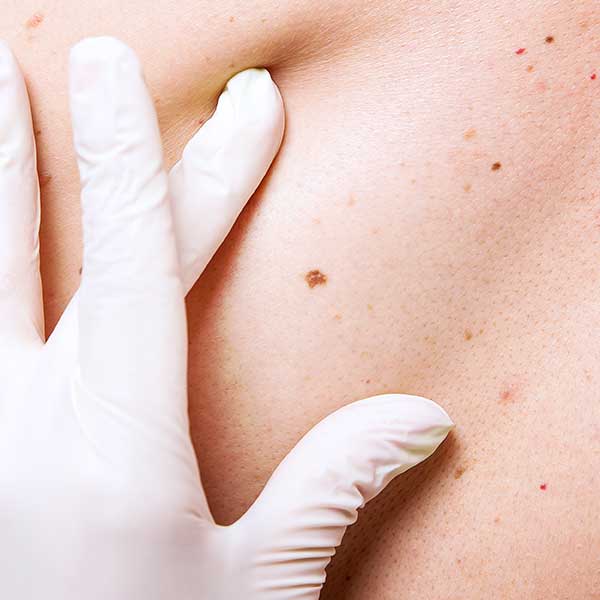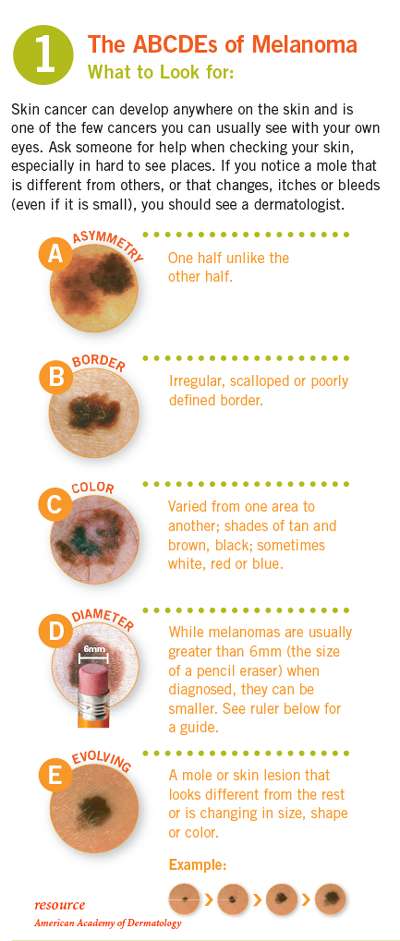Moles
Moles are growths on the skin that are usually brown or black. Moles can appear anywhere on the skin, alone or in groups.
Most moles appear in early childhood and during the first 30 years of a person’s life. It is normal to have between 10-40 moles by adulthood.
As the years pass, moles usually change slowly, becoming raised and/or changing color. Often, hairs develop on the mole. Some moles may not change at all, while others may slowly disappear over time.
What Causes a Mole?
Moles occur when cells in the skin grow in a cluster instead of being spread throughout the skin. These cells are called melanocytes, and they make the pigment that gives skin its natural color. Moles may darken after exposure to the sun, during the teen years, and during pregnancy.
Congenital nevi are moles that are present at birth. Congenital nevi occur in about one in 100 people. These moles may be more likely to develop into melanoma (cancer) than are moles that appear after birth. A mole or freckle should be checked if it has a diameter of more than a pencil eraser or any characteristics of the ABCDEs of melanoma (see below).
Dysplastic nevi are moles that are typically larger than average (larger than a pencil eraser) and irregular in shape. They tend to have uneven color with dark brown centers and lighter, uneven edges. These nevi are more likely to become melanoma. In fact, people who have 10 of more dysplastic nevi have a 12 times higher chance of developing melanoma, a serious form of skin cancer. Any changes in a mole should be checked by a dermatologist to evaluate for skin cancer.
Examine your skin with a mirror or ask someone to help you. Pay special attention to areas of the skin that are often exposed to the sun, such as the hands, arms, chest, neck, face, and ears.
If a mole does not change over time, there is little reason for concern. If you see any signs of change in an existing mole, if you have a new mole, or if you want a mole to be removed for cosmetic reasons, talk to your dermatologist.
The following ABCDEs are important characteristics to consider when examining moles. If a mole displays any of the signs listed below, have it checked immediately by a dermatologist. It could be cancerous.
- Asymmetry. One half of the mole does not match the other half.
- Border. The border or edges of the mole are ragged, blurred, or irregular.
- Color. The color of the mole is not the same throughout or has shades of tan, brown, black, blue, white, or red.
- Diameter. The diameter of a mole is larger than the eraser of a pencil.
- Evolution. The mole is changing in size, shape, or color.
How Are Moles Treated?
If a dermatologist believes a mole needs to be evaluated further or removed entirely, he or she will either remove the entire mole, or first take just a small tissue sample of the mole to examine thin sections of the tissue under a microscope (a biopsy). This is a simple procedure. (If the dermatologist thinks the mole might be cancerous, cutting through the mole will not cause the cancer to spread.)
If the mole is found to be cancerous, and only a small section of tissue was taken, the dermatologist will remove the entire mole by cutting out the entire mole and a rim of normal skin around it, and stitching the wound closed.


